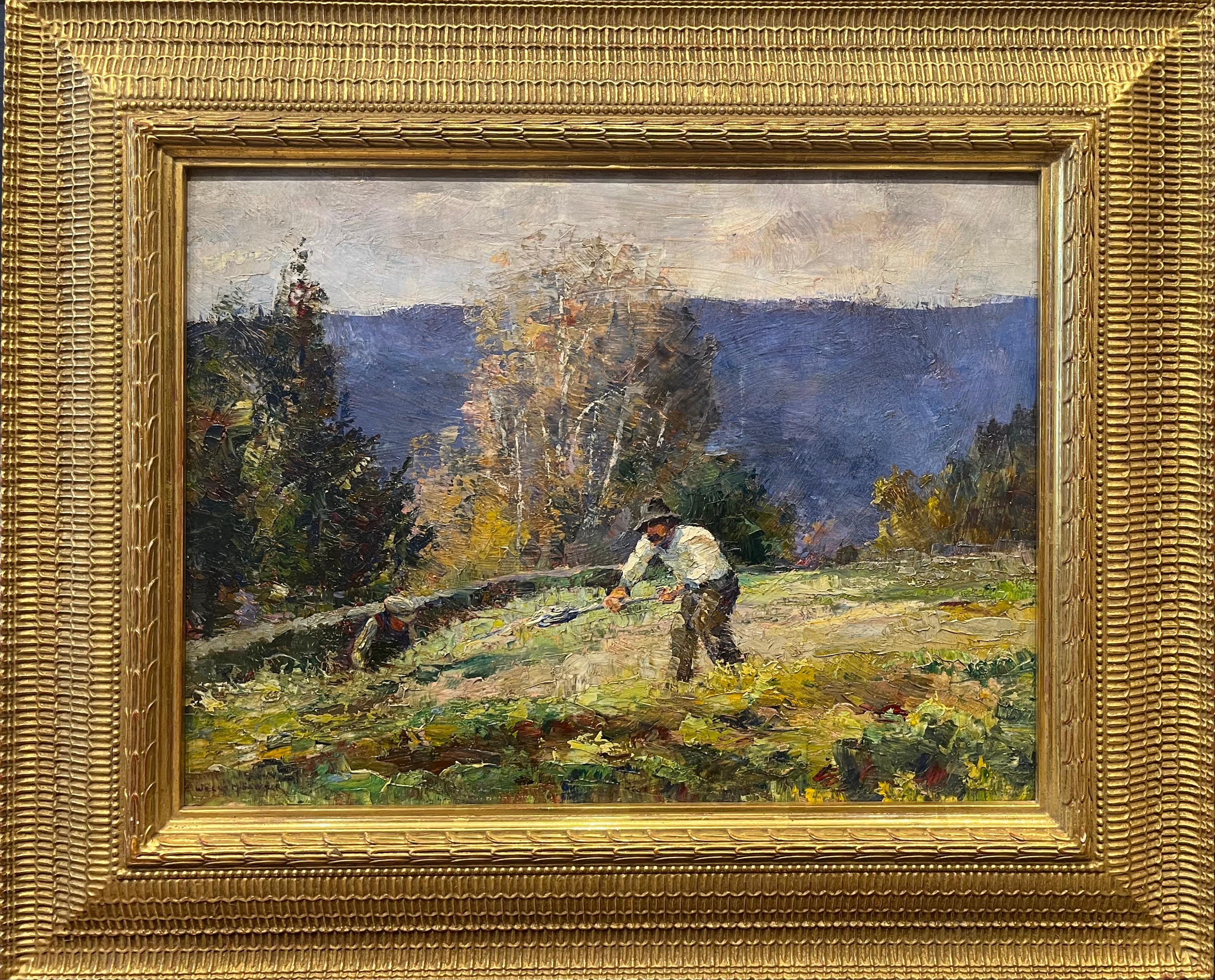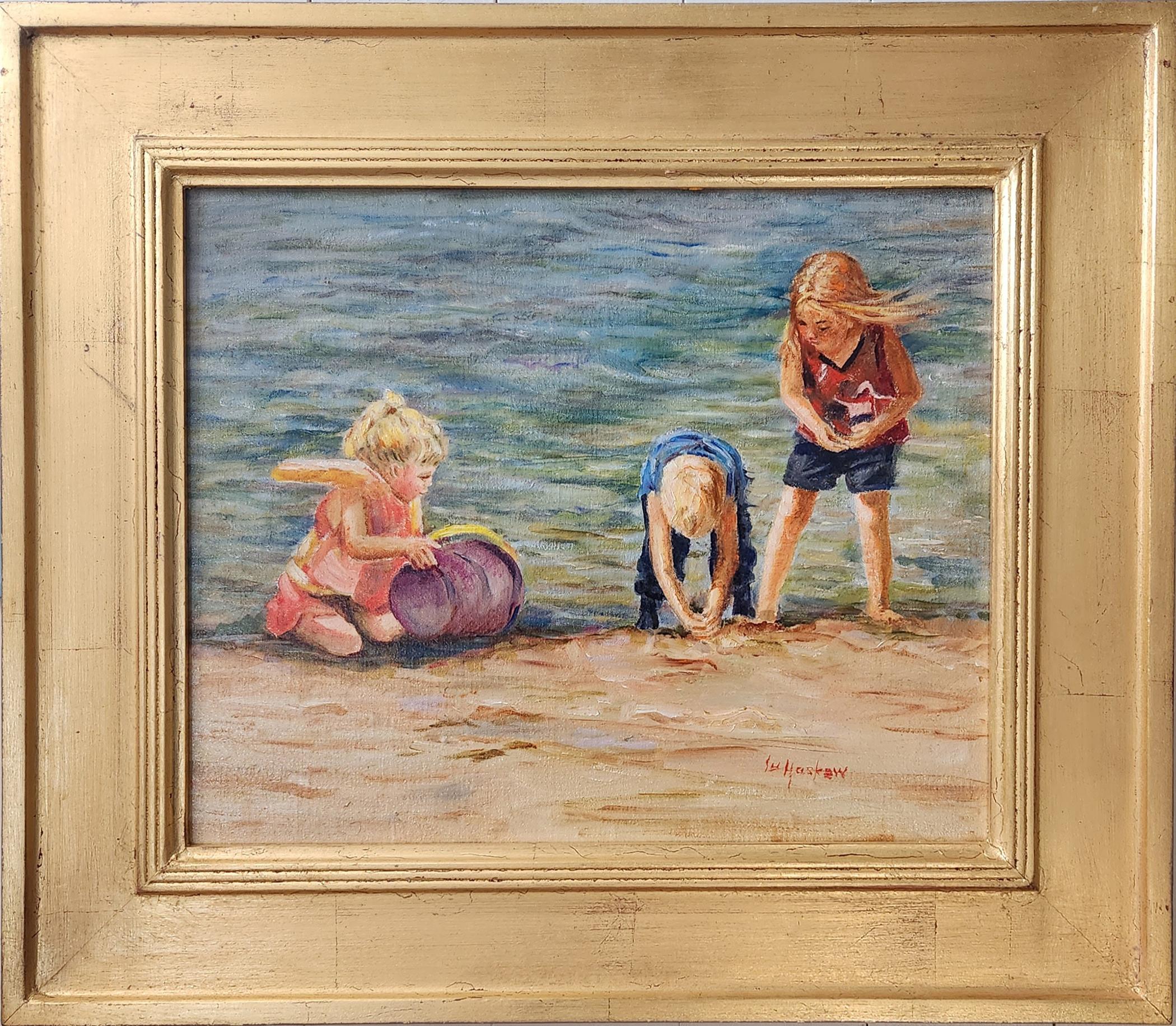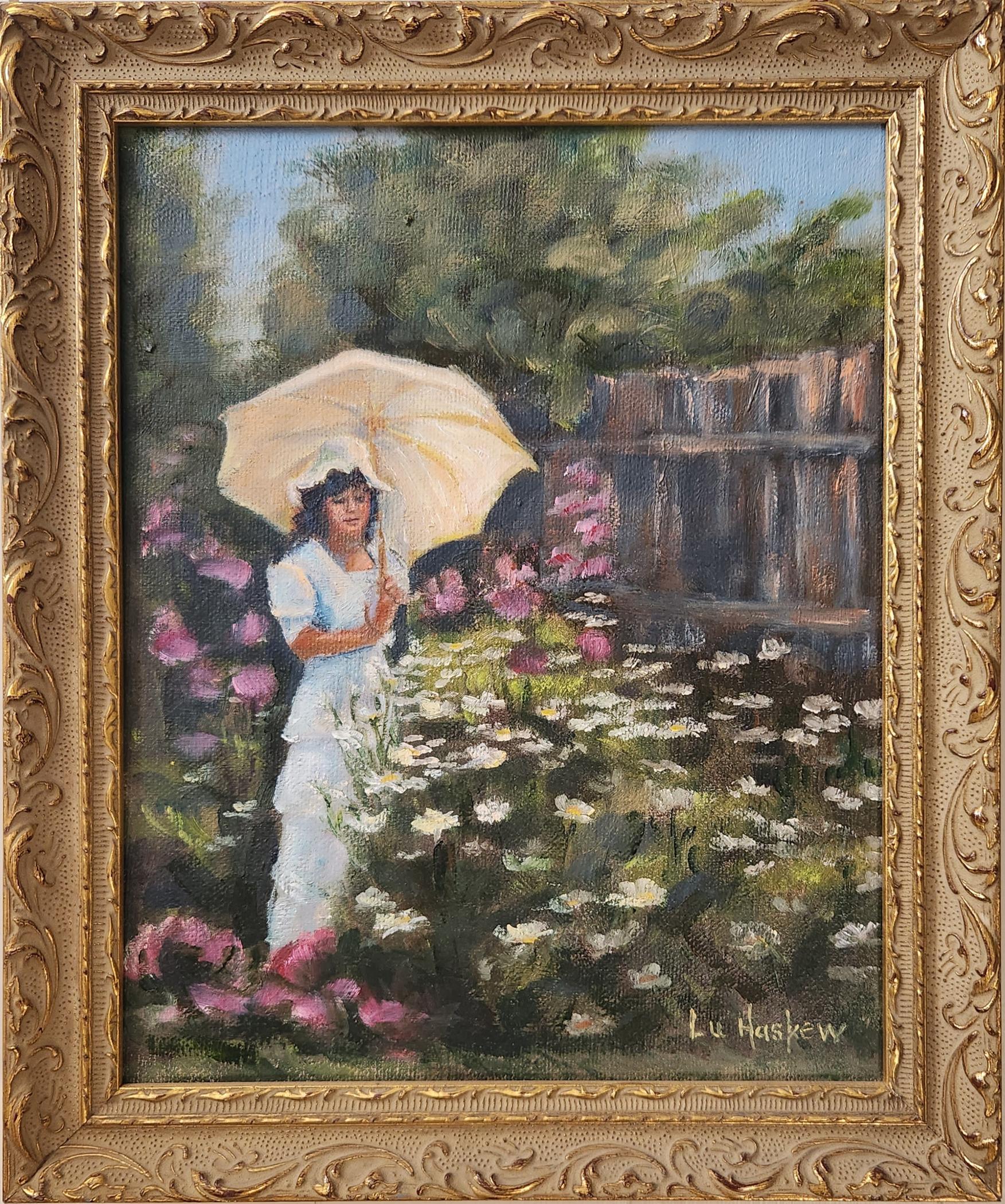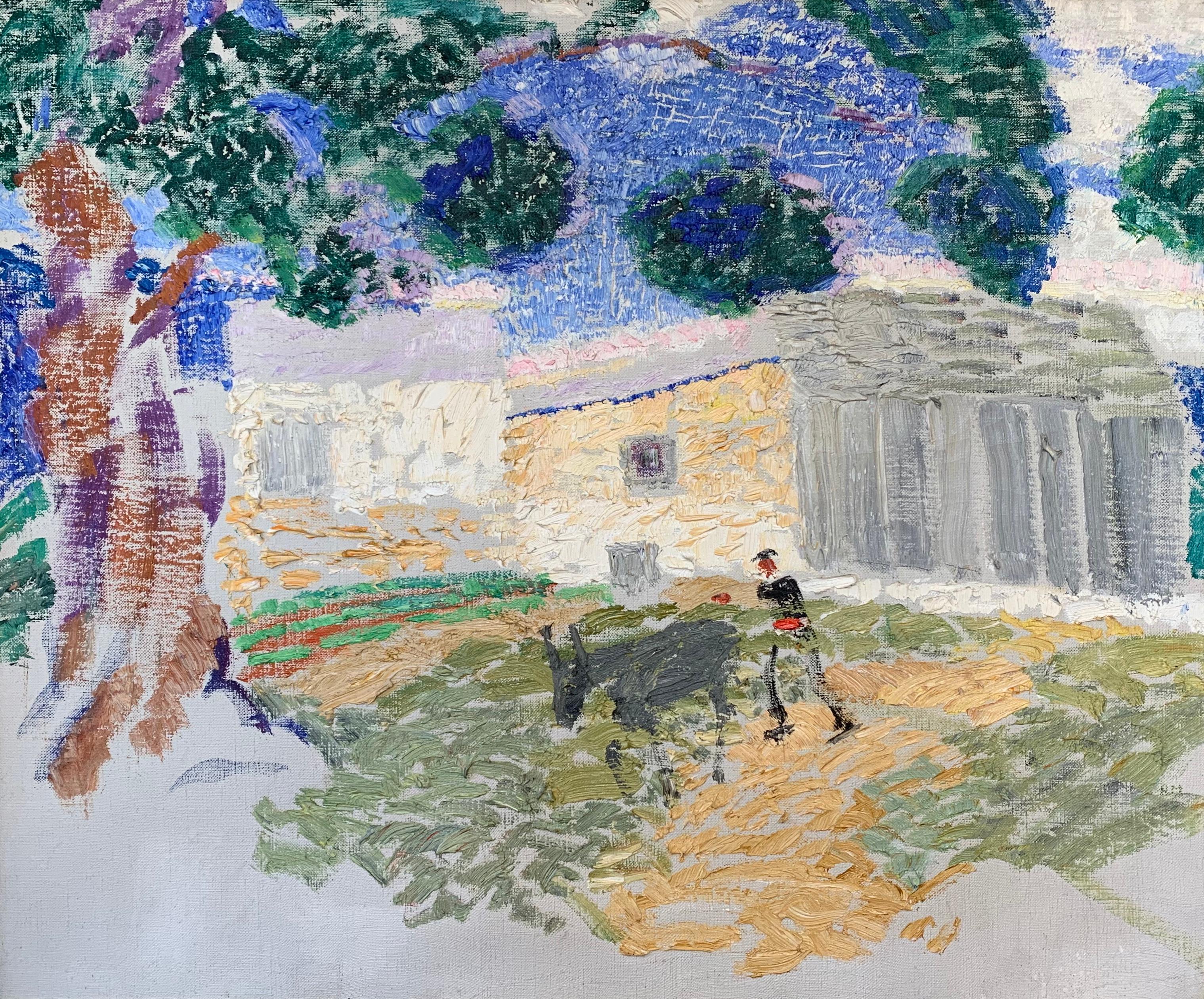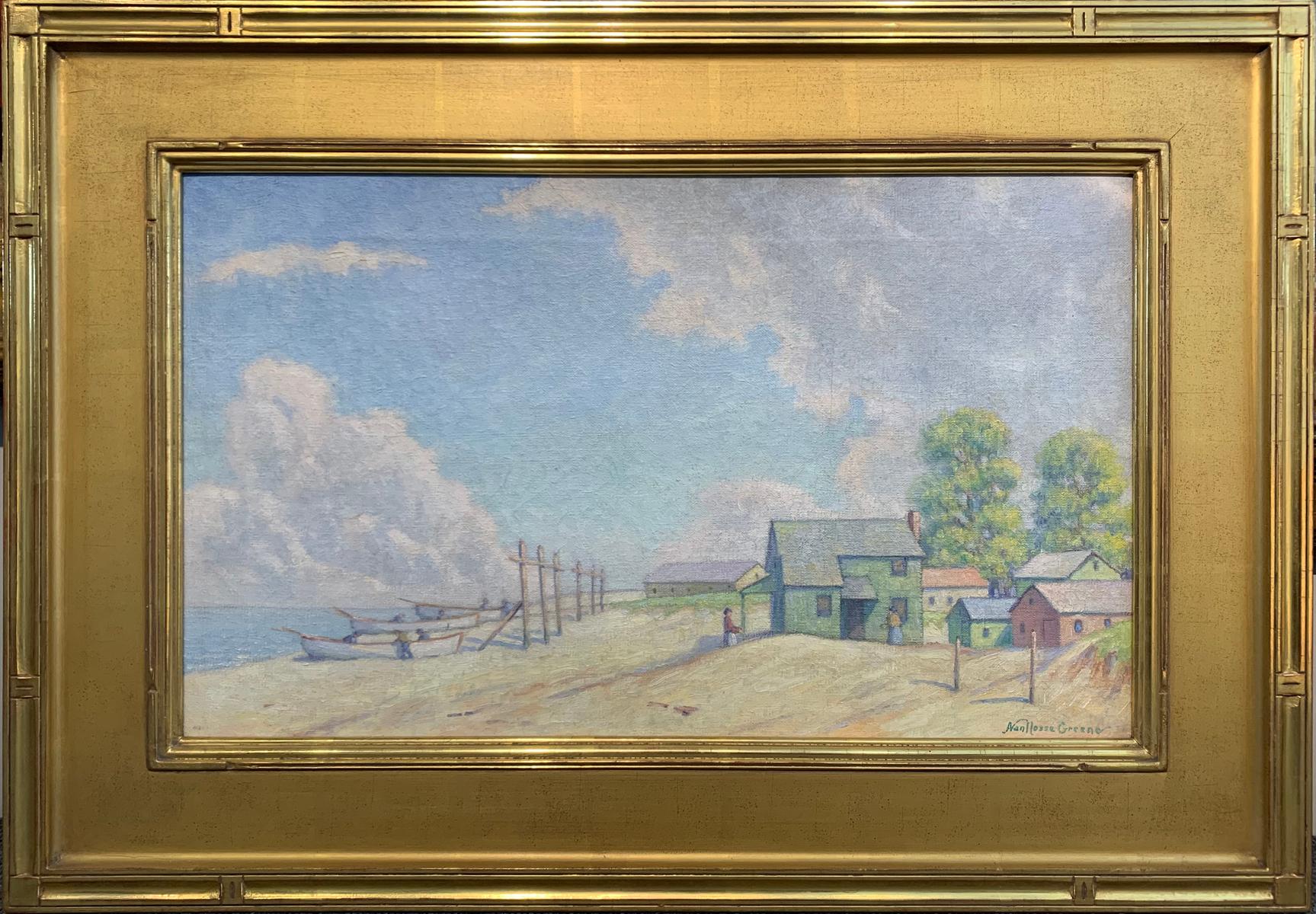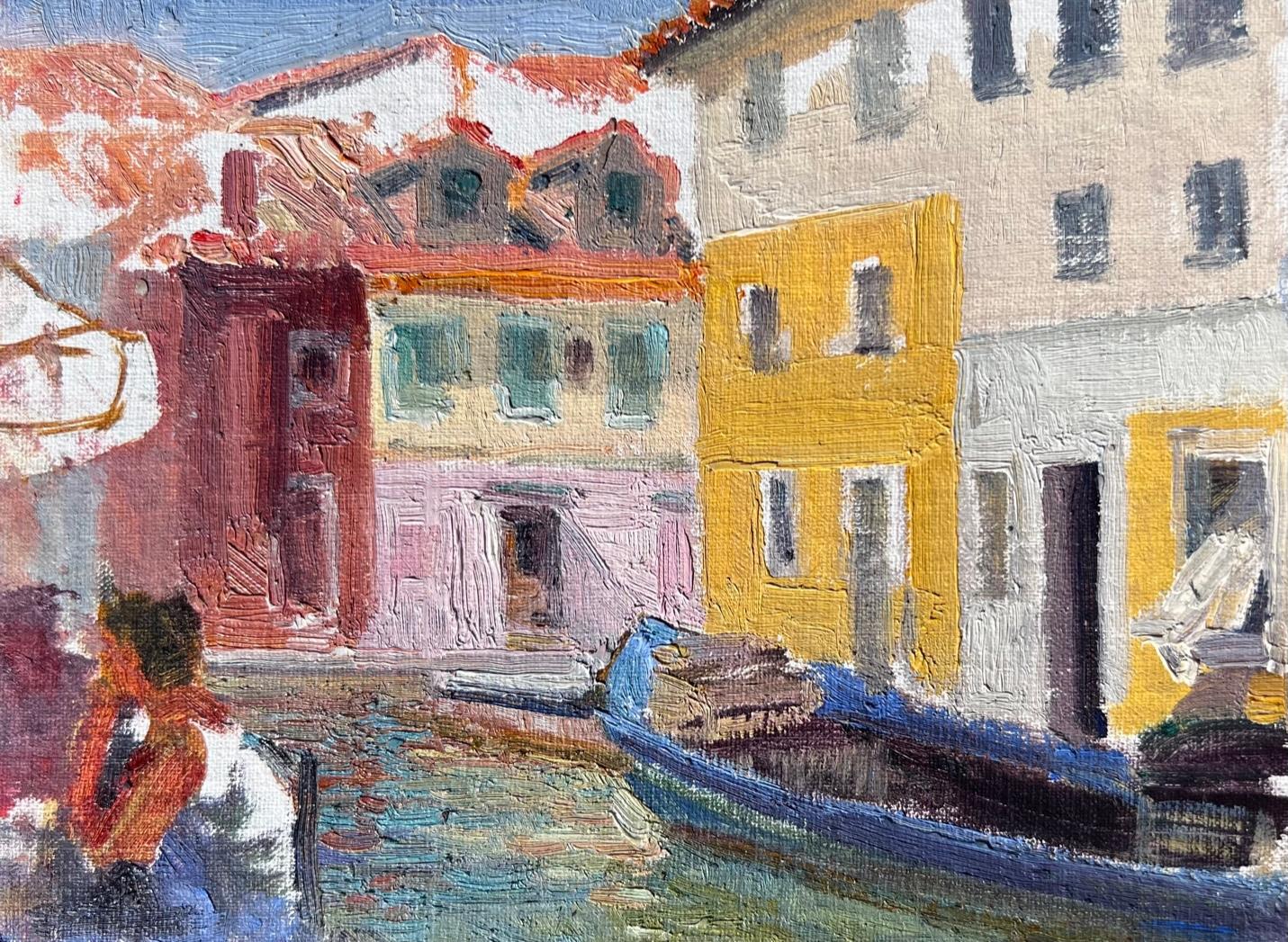Items Similar to "A Man in His Garden, " Emil Carlsen, Backyard and Barn Impressionist Landscape
Want more images or videos?
Request additional images or videos from the seller
1 of 9
Emil Carlsen"A Man in His Garden, " Emil Carlsen, Backyard and Barn Impressionist Landscape1893
1893
About the Item
Soren Emil Carlsen (1848 - 1932)
A Man in His Garden, 1893
Oil on canvas
28 3/4 x 35 1/2 inches
Signed and dated lower right
Provenance:
The artist [1848-1932]
Macbeth Gallery, New York
Grand Central Art Galleries, New York
Luella May (Ruby) Carlsen (the artist's wife), New York
Dines Carlsen (the artist's son), Falls Village, Connecticut
Private Collection, Miami, Florida
Exhibited:
New York, Macbeth Gallery, Summer Exhibition: Painting by American Artists, July - August, 1926, no. 31 (as The Man in the Garden).
Houston, Texas, Museum of Fine Arts, Exhibition of Contemporary American Art by Members of the Grand Central Art Galleries, January 13 - 27, 1929 (as The Man in the Garden).
Miami Antique Fair, 2013.
This work is recorded in the artist's archives recorded by Bill Indursky.
Regarded today as one of the more prominent artists of the late 19th Century, Emil Carlsen spent many years as a penniless painter on the fringes of the art world, while he continued developing his still-life painting techniques that would take the rest of the art world several decades to fully appreciate.
Some historians have described Carlsen as having a rather uneventful life, and while there may be an absence of the kind of unpredictability and turbulence that make for interesting biographies, Carlsen's life seems, in retrospect, anything but dull. There was something of a bohemian streak in his personality, living in a remarkable number of places during the first many decades of his career.
Born Soren Emil Carlsen in Copenhagen around 1853, Carlsen first began his studies at the Royal Danish Academy as a teenager. Yet he was not to remain long there, leaving in 1872, at nineteen years old for America where he settled in Chicago, working for an illustration house to support himself.
By 1875, he had saved enough money to travel to both Paris and Copenhagen to paint and study, staying for six months before returning to America, this time to New York. By this time he had already developed a unique love affair with the still life. In New York he befriended fellow painters such as John Francis Murphy; yet the city could not contain him, and after only a year he relocated to Boston, where he developed a life-long friendship with Childe Hassam.
Carlsen remained quite poor throughout his time in Boston where he spent the next eight years. Yet his abilities were developing quite rapidly in still life painting, in a style which scholars refer to as "kitchen still lifes." These were still life scenes that often included fish or birds along with pots and pans which gave implied presence of the cook outside the frame, giving them a more human element than most still life subjects. This style very much echoed the work of the Dutch and Spanish Masters of still life, particularly that of Jean Simeon Chardin and, to a lesser degree, Johannes Vermeer. The similarity is not coincidental, as Carlsen spoke and wrote often of the influence of these artists on his own work, and yet he was already beginning to develop the eye for color, light and composition that today we regard as the undeniable Carlsen style.
In 1884 Carlsen moved again to Paris, staying for two years. Here, as always he kept a low profile, preferring the mediation of working in the studio to the more social and recreational gathering places of artists and expatriates. In 1887, Carlsen moved to San Francisco, working for the directorship of the San Francisco Art Association School, and in 1891 moved back to New York where he lived until 1901. It is during this period, in the last decade of the nineteenth century that could be regarded as the most formative in terms of the development of the techniques that produced the paintings for which he is most celebrated today.
Though still life had been an established genre throughout the century, it was not the easiest genre with an artist could earn a place in salons and was less reliable as a salable work of art. Often encouraged by other artists and would-be patrons to switch over to landscapes and marines to make better money, Carlsen resisted this for many years, remaining stubbornly in his pursuit of the still life. And when one looks at examples of Carlsen's work in this crucial transitory phase, one can tell that he felt himself truly on the verge of something wonderful. Many other artists perhaps felt the still life genre to have exhausted itself; that it offered few possibilities for new ground, and that it was certainly not a genre on which one bases the core of their work.
Yet as Carlsen began to move away from the traditional arrangements and elements of still lifes, he became increasingly fascinated by textures like the copper, bronze, brass and silver of pots and bowls and the shadows that their curves and lines produced against shaded backdrops. While the Dutch still life painters had already developed the moody tones of dark pockets and shadows, Carlsen brought out a great range of the emotions that accompany that moodiness. As he progressed, Carlsen managed to decontextualize the objects in his paintings, until they were no longer just brass and copper pots or the pure effects of the colors they radiated, but something in between; where it was no longer the actual use or purpose of an object that mattered in relation to other objects around them or the arbitrariness of their arrangement together, but the very singular existence of the objects themselves, separated from the people and the ordinary use they would have for it, as well as the ordinary light in which they would usually be seen. The dimness of the light only added to the mystery. And yet Carlsen's fascination with surfaces made him often instill his shadows with great textures that played with and complemented the qualities of the objects that seem to glow from the canvas. The effect is that even the 'somber' darkness of the shadows seem to radiate light and color.
It was not until the 1910's and 20's that Carlsen began to really benefit financially from his painting, even though he'd already had the respect of his fellow artists all along. Despite his long career and his wide travels, he left few written accounts of his travels, and thus there are many in his biography that historians have tried to reconstruct. His habit of dating some pictures and leaving others blank has also made it difficult to reconstruct the exact progression of his technique from picture to picture. He often abandoned certain traits only to pick them up again before finally discarding them as he honed his style and his eye. The result is evidence of an artistic meditation that progressed with consistency and caution.
Carlsen's death in 1932 was at the height of his popularity, and he left behind an admirable body of work in which he had redefined the cerebral and metaphysical effects a still life can have on a viewer. Then he broke the mold. Surviving him was his son Dines who had already become very successful in his own right, developing even further the unique techniques of color, light ands texture in still life from his father.
- Creator:Emil Carlsen (1853-1932, American)
- Creation Year:1893
- Dimensions:Height: 38 in (96.52 cm)Width: 45 in (114.3 cm)
- Medium:
- Movement & Style:
- Period:
- Condition:
- Gallery Location:New York, NY
- Reference Number:1stDibs: LU184129917322
About the Seller
5.0
Platinum Seller
These expertly vetted sellers are 1stDibs' most experienced sellers and are rated highest by our customers.
Established in 2021
1stDibs seller since 2022
60 sales on 1stDibs
Typical response time: 1 hour
- ShippingRetrieving quote...Ships From: New York, NY
- Return PolicyA return for this item may be initiated within 3 days of delivery.
More From This SellerView All
- "Elegant Lady in Winter, Trinity Church, New York" Herman Hyneman, Gilded AgeBy Herman HynemanLocated in New York, NYHerman N. Hyneman (1849 - 1907) Elegant Lady in Winter, Trinity Church, New York City Oil on canvas 22 x 15 inches Signed lower right Provenance: Freemans, 2005, Lot 76 Herman N. Hyneman was a noted American portrait and figure painter with ties to both Philadelphia and New York. He was born July 27,1849 to Leon and Adeline Hyneman in Philadelphia. ("Who Was Who in American Art" lists his birth date as either 1849 or 1859, but we have confirmed that the birth date is 1849). Virtually nothing is known about his early years, but given the fact that the family resided in a wealthy section of Philadelphia and the fact that he traveled to Paris to study in the studio of Leon Bonnat when he was but 20 years old, it is presumed that the family was financially comfortable if not well to do. Hyneman exhibited at the Paris Salon in 1879 and 1881, which was quite an accomplishment given his tender age. He returned to the United States in 1882 and after a year in Philadelphia, he established a studio at 58 West 57th Street, New York, NY, where he painted portraits to support himself and scenes of beautiful fair-skinned women walking in the snow to exhibit at major exhibitions throughout the United States. Hyneman exhibited at the the Brooklyn Art Association in 1882, 1883 and 1884 and at the Pennsylvania Academy of Fine Arts in 1883 and 1888. Beginning in 1882 and continuing up until 1905, he exhibited regularly at the National Academy of Design. Despite the fact that he exhibited fourteen paintings at the National Academy over a span of three different decades, he was never elected as a member. In the 1880's his paintings sold for between $100 and $1500, which were substantial sums for that period. Hyneman also exhibited at the Salmagundi Club and the Philadelphia Art Club and was a member of each organization. He won a medal at the American Art Society in 1904 and also exhibited at the Chicago Art Institute. A handwritten label on one of his paintings indicates that he also exhibited in Budapest, Hungary. In 1892, Hyneman married the noted artist Juliet Jolley (aka Jolly), who had previously modeled for him. Thereafter, they shared a studio and on at least one occasion exhibited together. The February 5, 1896 edition of the "New York Times" reported on a "pleasant studio reception" at 58 West 57th Street where the paintings of both Herman and Juliet were shown to members of New York Society including Mr. And Mrs. Edwin Blashfield. At least one of Hyneman's Painting " A Sensation on Wall Street" which depicted a lovely young woman in fur coat with Muff in front of the Stock Exchange, was made into a post card and reproductions of his paintings are known to exist, although not plentiful. At least one etching is known, "Desdemona," which was reproduced in a book by Frederic Stokes. Herman Hyneman...Category
Late 20th Century American Impressionist Landscape Paintings
MaterialsCanvas, Oil
- "The Green Parasol, " Henry Hannig, American Impressionist, Woman in Beach SceneBy Henry HannigLocated in New York, NYHenry Charles Hannig (1883 - 1948) The Green Parasol Oil on canvas mounted on board 6 x 7 3/4 inches Provenance: R.H. Love Galleries, Chicago, Illinois Private Collection, Lake Orion, Michigan Hannig, born in Hirschberg, Germany on 27 February 1883, came to America with his parents at the age of seven. He attended school in the southwest suburbs before the family settled in Chicago. Young Henry enrolled in the Chicago Academy of Fine Arts where Lawton Parker became his mentor. He made ends meet by working in industrial design and illustration. By 1908 he was a pupil in the School of the Art Institute of Chicago where students followed the traditional European drawing curriculum, beginning with the copying of master engravings and drawing after plaster casts, then concentrating on the nude figure. Students worked toward the goal of winning various academic prizes. One of Hannig's fellow students was Louis Ritman...Category
1910s American Impressionist Figurative Paintings
MaterialsCanvas, Oil, Board
- "Sensation in Wall Street, New York" Herman Hyneman, Jewish Artist, Gilded AgeBy Herman HynemanLocated in New York, NYHerman N. Hyneman (1849 - 1907) Sensation in Wall Street, New York, 1903 Oil on canvas 24 x 16 inches Signed and dated lower left Provenance: Roger King, Newport, Rhode Island Herman N. Hyneman was a noted American portrait and figure painter with ties to both Philadelphia and New York. He was born July 27,1849 to Leon and Adeline Hyneman in Philadelphia. ("Who Was Who in American Art" lists his birth date as either 1849 or 1859, but we have confirmed that the birth date is 1849). Virtually nothing is known about his early years, but given the fact that the family resided in a wealthy section of Philadelphia and the fact that he traveled to Paris to study in the studio of Leon Bonnat when he was but 20 years old, it is presumed that the family was financially comfortable if not well to do. Hyneman exhibited at the Paris Salon in 1879 and 1881, which was quite an accomplishment given his tender age. He returned to the United States in 1882 and after a year in Philadelphia, he established a studio at 58 West 57th Street, New York, NY, where he painted portraits to support himself and scenes of beautiful fair-skinned women walking in the snow to exhibit at major exhibitions throughout the United States. Hyneman exhibited at the the Brooklyn Art Association in 1882, 1883 and 1884 and at the Pennsylvania Academy of Fine Arts in 1883 and 1888. Beginning in 1882 and continuing up until 1905, he exhibited regularly at the National Academy of Design. Despite the fact that he exhibited fourteen paintings at the National Academy over a span of three different decades, he was never elected as a member. In the 1880's his paintings sold for between $100 and $1500, which were substantial sums for that period. Hyneman also exhibited at the Salmagundi Club and the Philadelphia Art Club and was a member of each organization. He won a medal at the American Art Society in 1904 and also exhibited at the Chicago Art Institute. A handwritten label on one of his paintings indicates that he also exhibited in Budapest, Hungary. In 1892, Hyneman married the noted artist Juliet Jolley (aka Jolly), who had previously modeled for him. Thereafter, they shared a studio and on at least one occasion exhibited together. The February 5, 1896 edition of the "New York Times" reported on a "pleasant studio reception" at 58 West 57th Street where the paintings of both Herman and Juliet were shown to members of New York Society including Mr. And Mrs. Edwin Blashfield. At least one of Hyneman's Painting " A Sensation on Wall Street" which depicted a lovely young woman in fur coat with Muff in front of the Stock Exchange, was made into a post card and reproductions of his paintings are known to exist, although not plentiful. At least one etching is known, "Desdemona," which was reproduced in a book by Frederic Stokes. Herman Hyneman...Category
Early 1900s American Impressionist Landscape Paintings
MaterialsOil, Canvas
- "Woman in a Forest Glade" Robert Lewis Reid, American Impressionist, French LadyBy Robert ReidLocated in New York, NYRobert Lewis Reid Woman in a Forest Glade Oil on canvas 36 x 27 inches Provenance: Petersen Galleries, Beverly Hills, California Hirschl & Adler Gal...Category
Late 19th Century American Impressionist Figurative Paintings
MaterialsCanvas, Oil
- "Brighton Beach" Nathan Hoffman, New York, Sunny Day Landscape ImpressionismLocated in New York, NYNathan Hoffman Brighton Beach, July 31, 1946 Signed, dated, and estate stamped on the reverse Oil on artist's board 10 x 13 1/2 inches Provenance: Esta...Category
1940s American Impressionist Landscape Paintings
MaterialsOil, Board
- "The Beach" Nathan Hoffman, Brooklyn, New York, Sunny Day LandscapeLocated in New York, NYNathan Hoffman The Beach Estate stamped on the reverse Oil on artist's board 10 1/4 x 14 inches Provenance: Estate of the artist Born in Russia, the s...Category
1940s American Impressionist Landscape Paintings
MaterialsOil, Board
You May Also Like
- Oil Landscape of Man Plowing Field Titled The Garden in AutumnLocated in Fredericksburg, VAThis painting depicts the world famous Untermeyer Garden in Yonkers, New York. Sawyer was an American painter, illustrator, and photographer. He took photographs and made paintings o...Category
Mid-20th Century American Impressionist Landscape Paintings
MaterialsCanvas, Oil
- Summer Fun, 12x14" oil on boardBy Lu HaskewLocated in Loveland, COSummer Fun by Lu Haskew Oil Painting of kids at play on the beach 12x14.5" image size 15x18.5" framed Shipping price includes the custom packing necessary for safe transport of fine...Category
Early 2000s American Impressionist Figurative Paintings
MaterialsCanvas, Oil, Board
- In the Garden, 10x8" oil on boardBy Lu HaskewLocated in Loveland, COIn the Garden by Lu Haskew Oil Painting of woman with an umbrella in a backyard garden 10x8" image size 14x12" framed Shipping price includes the custom packing necessary for safe t...Category
Early 2000s American Impressionist Figurative Paintings
MaterialsCanvas, Oil, Board
- Plowing the Fields, American Impressionist Landscape with Figure and AnimalBy Henry McCarterLocated in Doylestown, PA"Plowing the Fields" is an early 20th Century American Impressionist landscape by Pennsylvania Academy graduate and teacher Henry McCarter. The 20" x 24...Category
Early 20th Century American Impressionist Landscape Paintings
MaterialsCanvas, Oil
- Figures, Boats, and House - Cape May Point, NJ, Impressionist Beach Scene, 1940sBy Albert Van Nesse GreeneLocated in Doylestown, PA"Figures, Boats, and House - Cape May Point, NJ" is a Pennsylvania Beach Scene by American Impressionist painter Albert Van Nesse Greene. The ...Category
1940s American Impressionist Landscape Paintings
MaterialsOil, Canvas
- Burano, Italy, Impressionism , Landscape, Framed, Colors, Café, Plein AireLocated in Houston, TXBurano, Italy Color is part of newly released small works from V....Vaughan's collection of recent travels in Italy and France. V....Vaughan painted each of these on location "en plein air" It has an Impressionistic Style as seen in many of Virginia Vaughan...Category
2010s American Impressionist Landscape Paintings
MaterialsOil, Canvas
Recently Viewed
View AllMore Ways To Browse
Antique Kitchen Art
Brass Man
Man Painting Antique
Man In Kitchen
Antique Brass Framed Art
New York Central Lines
Antique Brass Painting
Antique Barn
Antique Barns
Garden Illustration
Man Oil Antique
The Antique Barn
Old Man Bronze
Danish Painting 19th Century
Antique Painting Kitchen
Dating Antique Picture Frames
Antique American Picture Frames
Antique Fish Painting
